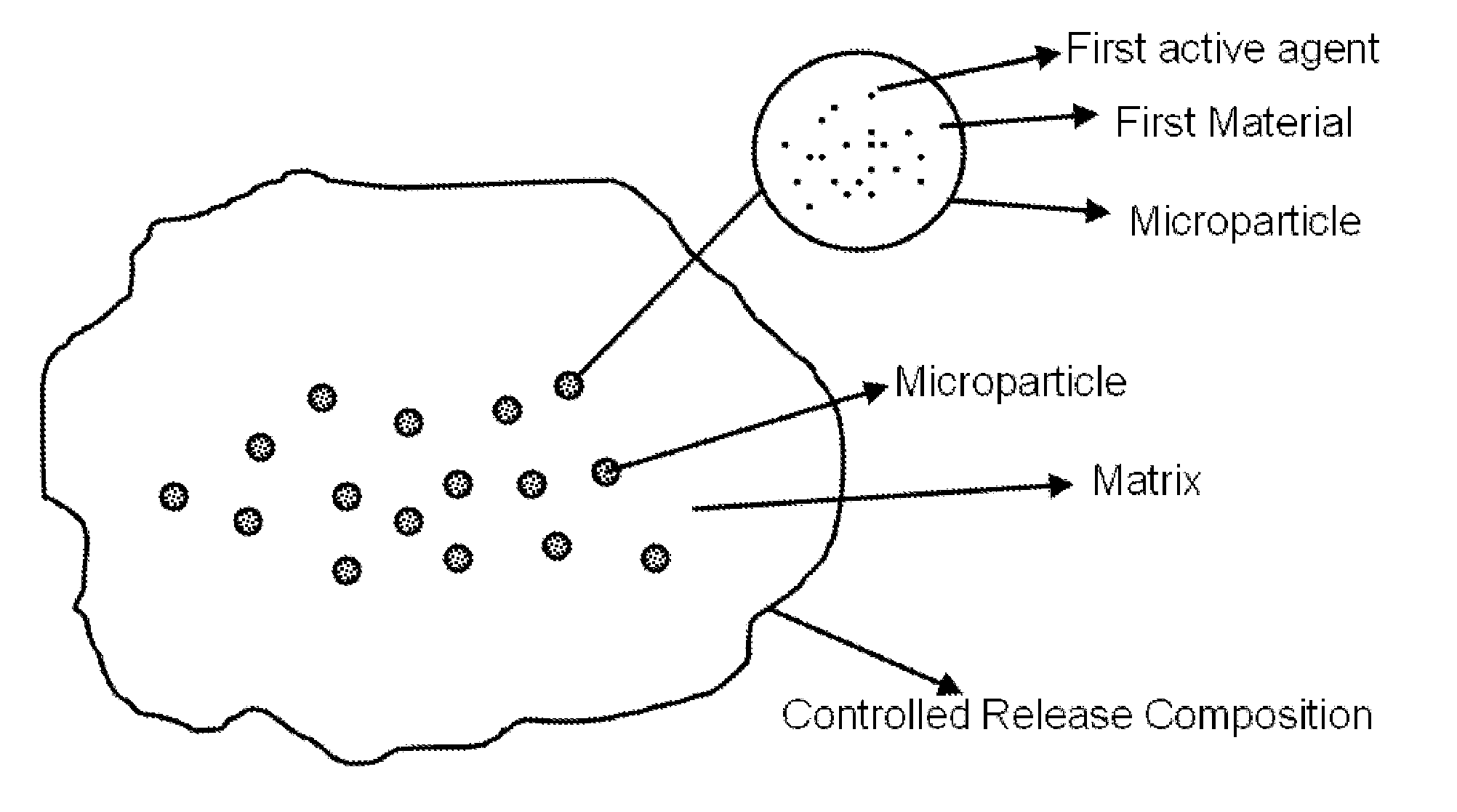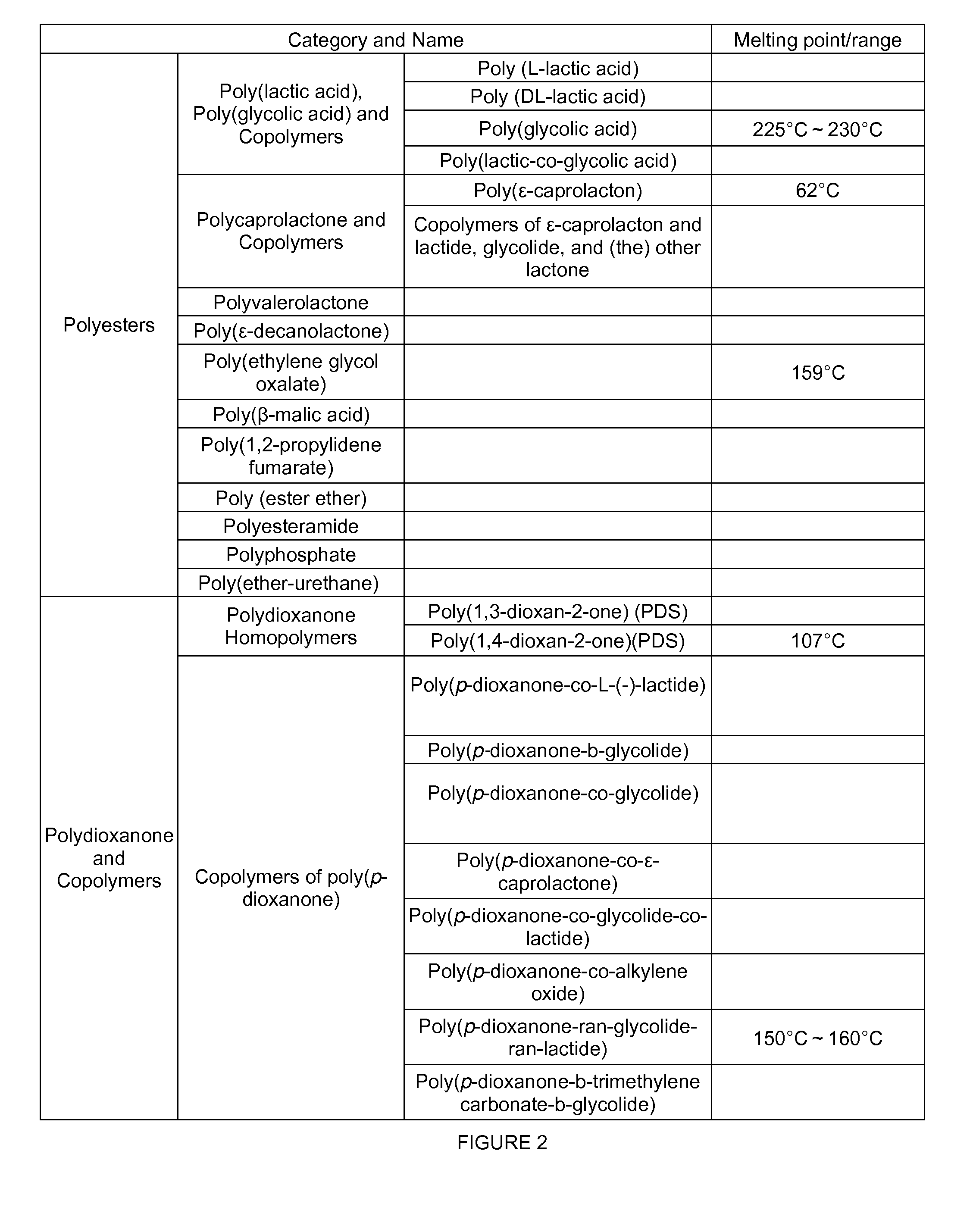Controlled releasing composition
a technology of controlled release and composition, applied in the direction of powder delivery, granular delivery, sheet delivery, etc., can solve the problems of significant affecting the properties of the controlled release composition, affecting the application of microparticle-based controlled release composition, and affecting the measurement of the drug release rate in tissues
- Summary
- Abstract
- Description
- Claims
- Application Information
AI Technical Summary
Benefits of technology
Problems solved by technology
Method used
Image
Examples
example 1
[0160]Preparation of fluorouracil microparticles: 6.0 g fluorouracil and 4.0 g poly(L-lactic acid) (MW 20,000; melting range 162-168° C.) were mixed and melted at 170° C. The melted mixture was cooled and the resulting solid was grinded to yield the fluorouracil microparticles (size: about 180 μm).
[0161]Preparation of fluorouracil implants: 20.0 g poly (L-lactic-glycolic acid) (75 / 25; MW 16,000; melting range 68-76° C.), 12.0 g fluorouracil, and 8.0 g fluorouracil microparticles were mixed and extruded at 110° C. Cylindrical granules about φ 0.9 mm×4 mm in size were prepared (fluorouracil content: 42.0%).
[0162]Thirty Kunming mice were randomized into 5 groups with 6 mice in each group. One fluorouracil implant was implanted into the medial hind leg muscle of each mouse. Samples were collected at time points as indicated in Table 3. In vivo cumulative release of fluorouracil by the implants was measured. And the results are as shown in Table 3.
TABLE 3Time1 day5 days15 days30 days50 d...
example 2
[0163]Preparation of fluorouracil microparticles: 6.0 g fluorouracil, 3.0 g poly (L-lactic acid) (MW 20,000; melting range 162-168° C.), and 1.0 g dextran (40) were mixed and melted at 170° C. The melted mixture was cooled and the resulting materials were grinded to yield the fluorouracil microparticles (size: about 180 μm).
[0164]Preparation of fluorouracil implants: 17.0 g poly (L-lactic-glycolic acid) (75 / 25; MW 16,000; melting range 68-76° C.), 3.0 g polyethylene glycol, 12.0 g fluorouracil, and 8.0 g fluorouracil microparticles were blended. Cylindrical granules about φ 0.9 mm×4 mm in size were prepared by injection molding at 110° C. Fluorouracil content in the implants was 42.0%.
[0165]Thirty Kunming mice were randomized into 5 groups with 6 mice in each group. 1-2 pieces of fluorouracil implants were implanted into the medial hind leg muscle of each mouse. Samples were collected at time points as indicated in Table 4. In vivo cumulative release of fluorouracil by the implants ...
example 3
[0166]Preparation of etoposide microparticles: 6.0 g dextran (40) was dissolved in 75% ethanol, followed by the addition of 10.0 g etoposide to create a mixture. Ethanol was evaporated from the mixture to form a paste, which was dried (80° C., −100 KPa, 8 hours) and grinded to yield etoposide microparticles (size: about 150 μm).
[0167]Preparation of etoposide implants: 3.0 g poly(L-lactic acid) (MW 20,000; melting range 162-168° C.) and 1.0 g polyethylene glycol (4000) were dispersed in ethanol. The mixture is desiccated and grinded to prepare microparticles of 150 μm in size. The microparticles were weighed, and mixed with etoposide microparticles at a ratio of 1:4 (w / w), respectively. The mixture was compressed to prepare cylindrical granules of φ 0.9 mm×2 mm in size. Etoposide content in the prepared etoposide implants was 50.0%.
[0168]Thirty Kunming mice were randomized into 5 groups with 6 mice in each group. One etoposide implant was implanted into the medial hind leg muscle of ...
PUM
| Property | Measurement | Unit |
|---|---|---|
| Temperature | aaaaa | aaaaa |
| Temperature | aaaaa | aaaaa |
| Temperature | aaaaa | aaaaa |
Abstract
Description
Claims
Application Information
 Login to View More
Login to View More - R&D
- Intellectual Property
- Life Sciences
- Materials
- Tech Scout
- Unparalleled Data Quality
- Higher Quality Content
- 60% Fewer Hallucinations
Browse by: Latest US Patents, China's latest patents, Technical Efficacy Thesaurus, Application Domain, Technology Topic, Popular Technical Reports.
© 2025 PatSnap. All rights reserved.Legal|Privacy policy|Modern Slavery Act Transparency Statement|Sitemap|About US| Contact US: help@patsnap.com



